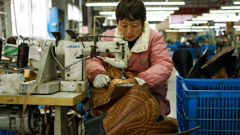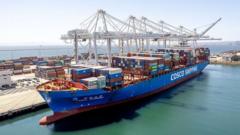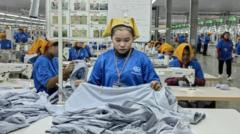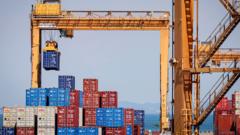In light of Donald Trump's possible return to tariffs on Chinese imports, Chinese businesses like boot manufacturers and garment factories are reevaluating their strategies. Many firms are already relocating to nations like Cambodia to circumvent potential financial burdens. The fallout of these tariffs could significantly reshape US-China trade relations and the global supply chain.
China's Preparedness for Trump’s Proposed Tariffs: A Look Inside the Manufacturing Impact

China's Preparedness for Trump’s Proposed Tariffs: A Look Inside the Manufacturing Impact
As Trump hints at new tariffs on Chinese goods, Chinese manufacturers brace themselves for potential upheaval, reshaping supply chains and exploring investment opportunities in countries like Cambodia.
Inside a factory on China's eastern coast, a flurry of activity surrounds the creation of American cowboy boots despite the uncertainty looming from the possibility of new tariffs proposed by Donald Trump. Sales manager Mr. Peng reflects on how a previous wave of tariffs drastically reduced production, dropping from a million pairs a year to fewer than 250,000. As Trump resumes power, Chinese businesses are concerned about what “Trump 2.0” could entail amidst a tense economic climate beginning to mirror the disruptive trade war initiated during his first term.
With apprehension gripping many manufacturers, the potential of a 10% tariff set to take effect on February 1 adds to a complicated narrative of economic dependency and manufacturing strategies. There’s now a solid trend of businesses relocating production out of China, with global giants such as Nike and Adidas setting up operations in Vietnam, while some are eyeing Cambodia as a less costly alternative.
The fear is palpable among employees like Mr. Peng, who has cultivated a familial relationship with the factory workforce over decades. Relocation may save costs, yet it would mean severing long-standing ties with workers who have invested decades of labor. The factory's production dropped dramatically after Trump’s tariffs in 2019, leaving its once-vibrant workstations eerily quiet. An uncertain future looms, where labor-intensive and low-cost production strategies no longer guarantee success within China.
The reverberations extend beyond individual enterprises. As American consumers grow increasingly wary of Beijing’s influence, the dynamics of trade have become a key tool in geopolitical bargaining. While the tariffs are aimed at reincarnating American manufacturing, they could also disrupt existing relationships. Commentators speculated that Trump might seek concessions from China in other global negotiations, particularly regarding issues like the Ukraine conflict or drug trafficking.
The tariffs could invoke a wave of relocations from China. Huang Zhaodong's operations in Cambodia illustrate this shift. His factories, producing high volumes for US retailers like Walmart, emphasize the significance of where production is based. Several manufacturers have opted to move, knowing that staying in China could represent financial suicide under tariff pressure.
Numerous players are evaluating the potential impacts, considering alternatives to ensure sustainability. Industry experts recommend looking toward regions like Africa or Latin America, which remain less integrated into the global supply chain.
Despite potential challenges, China's commitment to maintaining strong trade relationships remains evident. As the Belt and Road Initiative expands China’s influence, more than half of its trade now flows through these partnerships, illustrating a resilient and adaptive strategy for Chinese exporters.
As Mr. Peng expresses hope for dialogue between US and China to avert an adversarial approach, the greater narrative unfolds—a possible reset in US-China relations with ramifications felt across industries and borders. Understanding these dynamics is crucial for comprehension of the global economy, particularly as the business world adjusts to the imminent wave of tariffs and growing uncertainties surrounding trade policies.





















